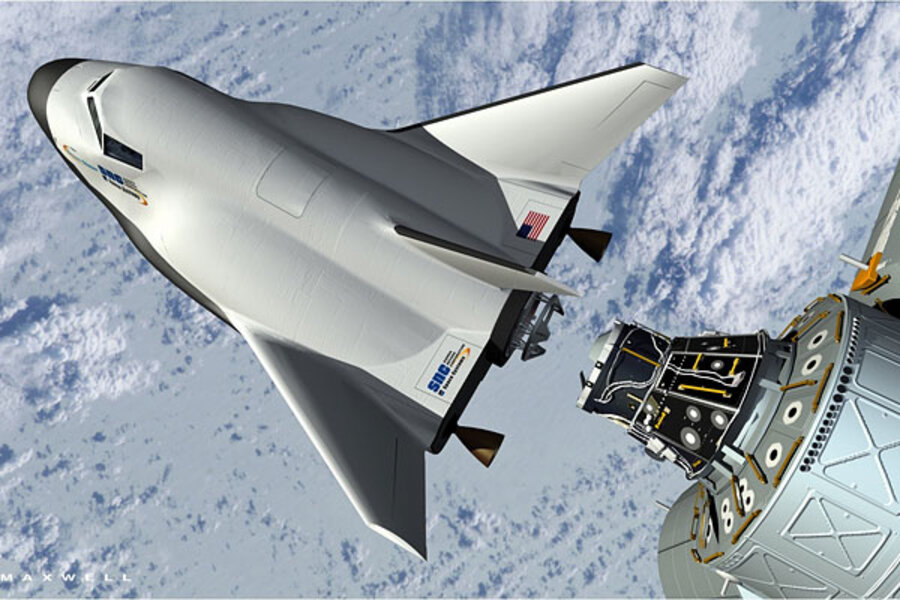Giant leap in race to replace space shuttle? Dream Chaser gets big boost.
Loading...
One of three companies vying to ferry US astronauts to and from the International Space Station has inked a multimillion dollar deal with aerospace giant Lockheed Martin in a move aimed at preparing a craft dubbed Dream Chaser for the task.
The move by Sierra Nevada Corp. highlights the pace at which the company's plans are morphing from plans on paper to hardware on the shop floor. "We're moving from concept to the next phase of the program, probably faster than most people realize," said Mark Sirangelo, who heads the company's space-systems division.
Through Lockheed Martin, Sierra Nevada will have access to expertise in using composite materials that Dream Chaser needs, as well as to large manufacturing facilities required to assemble several craft. In addition, Lockheed developed the Atlas V rocket, which is a likely launch vehicle for Dream Chaser, and has experience working with NASA to certify spacecraft for human spaceflight.
It appears to be a significant step forward for the aerospace company, which has been around for 25 years, but has previously focused on smaller ventures. The company has produced small satellites, components for projects such as the Mars Science Laboratory, and rocket motors, including motors for Burt Rutan's Spaceship One and its tourist version for Virgin Galactic, Spaceship Two.
The goal of the NASA commercial crew-transportation program is to free up NASA resources to focus on human exploration beyond low-Earth orbit. That means turning to private companies to build a spacecraft to service the space station, which also should help lay the foundation for a broader commercial human-spaceflight industry, advocates of commercialization say.
Last July, the agency divvied up contracts worth a combined $1.1 billion among three companies working on designs – Boeing, Space Exploration Technologies Corp. (SpaceX), and Sierra Nevada Corp. In December, NASA parceled another $29.6 million among the companies for parallel efforts that focus on meeting its performance and safety requirements.
Compared with the other two contenders' craft, Dream Chaser's design is unique. While Boeing and SpaceX are developing capsules, Dream Chaser is, in effect, a mini space shuttle, winged for a pilot-controlled landing at runways such as the one the shuttle used at the Kennedy Space Center. The craft is designed to carry up to seven people, including the flight crew, as well as cargo.
Within the next six to eight months, the company plans to conduct its first flight tests at NASA's Dryden Flight Research Center in Palmdale, Calif. The craft will be released from beneath a helicopter, then fly and land without human guidance.
The initial test is just to make sure the design can fly, says Jim Voss, a former NASA astronaut and vice president of the company's space-exploration systems division. The typical flight time will run from 30 to 40 seconds. Several more tests will be conducted, with different maneuvers added to each test, to take the full measure of its aerodynamic traits.
"We're starting a flight program, we are now starting to think about how to operate the system, how to create a transportation regime to low-Earth orbit and how to build multiple vehicles – all the things necessary to fly and fly within the next few years," says Mr. Sirangelo, adding that the new alliance with Lockheed will help Sierra Nevada meet its targets going forward.
SpaceX, based in Hawthorne, Calif., is working on a variant of its Dragon capsule. The capsule has made two cargo trips to the International Space Station so far, and is slated for two more this year under a cargo contract with NASA through at least 2015. The crewed version of Dragon would use rocket motors during the final moments of descent for a soft landing on Earth at mission's end. It would also include an escape system that could be used if a launch was aborted shortly after liftoff. The company has said it plans to test the escape system on the launch pad as early as next December.
The other entrant, Boeing, has teamed up with Bigelow Aerospace on another capsule-based approach to crew transportation that would also be expected to use the Atlas V as the launch vehicle.
Under NASA's contracts with the three companies, they receive incremental payments that are issued as they successfully meet agreed-upon milestones. If all three meet their milestones for the current contracts, NASA will have invested $1.5 billion in developing a commercial-crew capability for the US since 2009.







